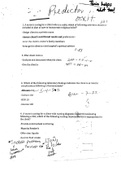Class notes
Forensics Psychology
- Course
- Institution
Involves notes on: - Offender Profiling (Top-Down & Bottom-Up Approach) - Biological Explanations: Atavistic Form - Biological Explanations: Neural - Biological Explanations: Genetic - Psychological Explanations: Eysenck's Theory - Psychological Explanations: Cognitive Explanations - Psychol...
[Show more]




